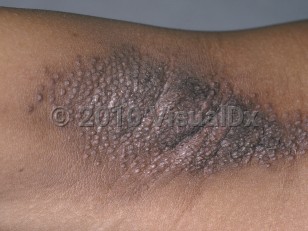Fox-Fordyce disease
See also in: AnogenitalAlerts and Notices
Important News & Links
Synopsis

It is most common in females between puberty and age 35. Less commonly, it can affect male patients, prepubescent girls, and postmenopausal women. It may flare perimenstrually and improve during pregnancy and after menopause.
Codes
L75.2 – Apocrine miliaria
SNOMEDCT:
65038009 – Fox-Fordyce disease
Look For
Subscription Required
Diagnostic Pearls
Subscription Required
Differential Diagnosis & Pitfalls

Subscription Required
Best Tests
Subscription Required
Management Pearls
Subscription Required
Therapy
Subscription Required
Drug Reaction Data
Subscription Required
References
Subscription Required
Last Updated:01/31/2021
 Patient Information for Fox-Fordyce disease
Patient Information for Fox-Fordyce disease - Improve treatment compliance
- Reduce after-hours questions
- Increase patient engagement and satisfaction
- Written in clear, easy-to-understand language. No confusing jargon.
- Available in English and Spanish
- Print out or email directly to your patient


